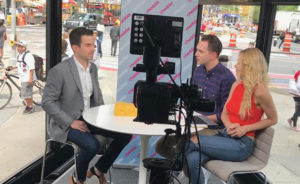I’ve been spending time this summer barnstorming Barnes & Noble bookstores in New England signing copies of my book on repairing climate change, The Age of Sustainability. These were my first visits to bookstores as a seller, not a customer — and I previously hadn’t visited a store in a while. I wasn’t prepared for what I found: The experience was palpable.
Like many people with busy lives, I’d gotten seduced by the convenience of going online to purchase what I wanted without understanding what I was giving up. It’s easy to understand the “get” of online purchasing. Online you have an infinite store shelf that never runs out and has literally everything you could think of. Unfortunately, that’s the problem too. Increasingly we are confronted by the reality that we only know so much — and worse, we don’t know what we don’t know.
The bookstore experience is designed for exploration and discovery — not the kind that pairs this purchase with others you’ve made or that others like you have made. The exploration happens against a rich background of color, smells and ideas. Your mind naturally skips from one book or magazine to another without much thought at times. Other times consciousness reasserts itself to make a selection or at least to do some reading.
The Cost of Relevance
The CRM industry has taken this natural process as one of the missions it seeks to provide an online analog for. We try to capture customer data in an effort to discover some hidden facts that could result in suggestions that help shorten the infinite store shelf, or at least make its contents completely relevant to the customer — but at what cost?
We have to accept a society in which all, or at least most, of our most intimate data can be accessed and crunched and, truth be told, sometimes used against us.
We’ve fallen in love with the idea that if we can only capture enough data, we can know or infer everything about a customer and then influence how they behave. The idea certainly seemed to work in 2016 when hackers captured enough data about voters to influence their decisions.
As an author, my mission in visiting bookstores is to understand people’s positions on my subject and to try to identify those who might be most receptive to my message. Hopefully, selling a few books this way will spark a trend, but maybe not. I haven’t yet met anyone who believes the hoax mantra of climate change (of course, I live in New England) but that doesn’t translate into immediate sales.
Same Business, Different Dates?
What I was not prepared for was the assortment of offerings and the really nice (there’s no other way to put it) people who staff the places. At the bookstores, I discovered that some people might be very happy not knowing what they want or need and may enjoy browsing the shelves.
As luck would have it, my experiences in bookstores coincides with the Amazon Prime Day sale, a time when “subscribers to the company’s Prime service get major discounts on everything from flat-screen TVs to Ben & Jerry’s ice cream,” according to The New York Times.
Success has its drawbacks, though, and they’re not all happy problems. For instance, the same article notes that more than 250 retailers have ongoing sales to compete with Prime Day, which is really two days.
Many retailers are concerned that this sale won’t generate new business but simply borrow from or cannibalize what reasonably could be expected from back-to-school sales in August. They might be right.
Retail and capitalism in general have growth as their primary drivers. Modern businesses have to show a modicum of growth every year or risk losing support from the financial markets that keep their stocks buoyant. Yet there’s a competing phenomenon, a pillar of capitalist economics called “Say’s Law,” which simply states that all markets clear at a price.
The meaning of this simple phrase is sometimes debated. On one hand, it’s a tautology: Yes, markets clear (all goods are sold) and we sell them for a price. What’s interesting to economists is the price of the clearance.
Are margins healthy, or are they marked down just to move merchandise? In the latter case, clearance happens but profit may not. Revenues might expand, but when profits don’t follow, investors worry about that too. So will Amazon Prime Day be something special or just another exercise in cannibalism?
The Value of Serendipity
The function of any retailer is to move merchandise profitably, maintaining margins in the process. That’s where CRM comes in, especially marketing in all of its forms. However, CRM can’t make new demand — it can only organize the demand that’s out there.
Regardless, being a good customer means more than taking the advice of algorithms or engaging with the brand’s just-so experience. It means being true to yourself and your own interests, and sometimes that means breaking out of the mold someone else has set for you.
Because of that, I don’t think we’ll ever get to the point where there’s perfect alignment between the vendor and customer. At least I hope not, because it will be the end of serendipity.
On my way out of the store over the weekend, I paused at a magazine section dedicated to art, its practice and the business. I do a little painting — I am not very good, but doing it satisfies a need. I saw and bought PleinAir, a magazine about painting outdoors the way the Impressionists first did.
I never knew the magazine existed and wouldn’t to this day if I hadn’t taken the time to get away from the infinite store shelf and its algorithms. As Robert Frost once observed, “that has made all the difference.”















































Social Media
See all Social Media